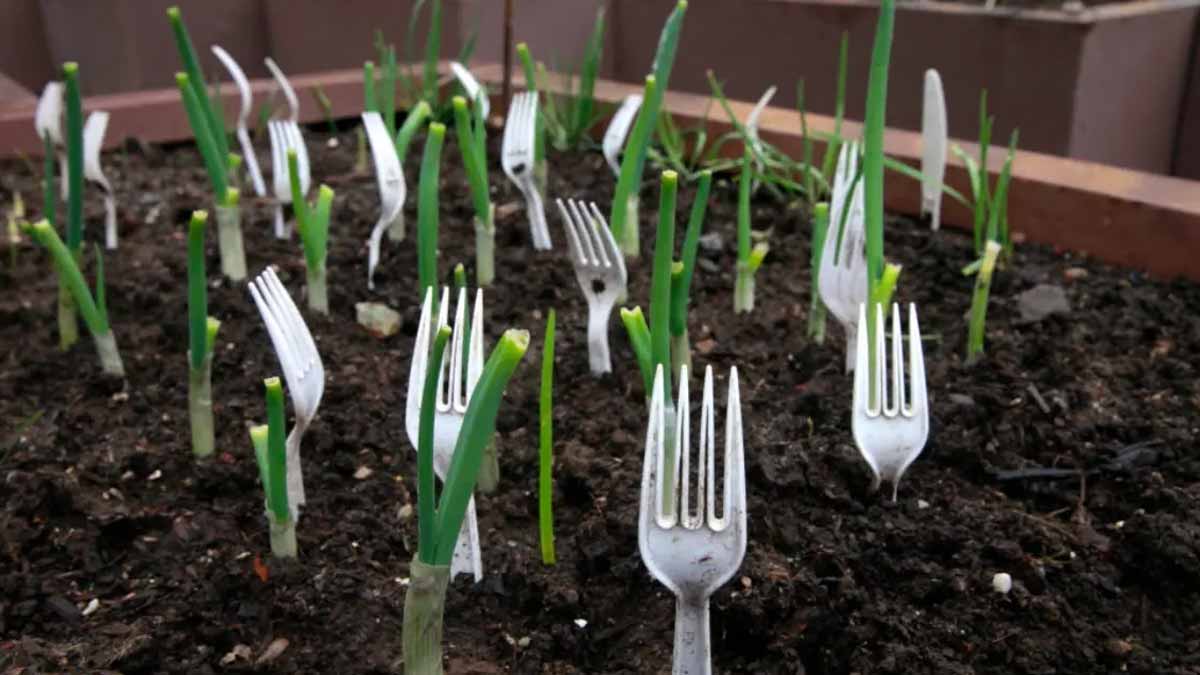Quick hands, simple tools, and a small twist reshape daily care in the vegetable garden. Plastic forks, set with tines up, stop trouble before it starts because animals dislike sharp, cramped ground. The result feels calm, so seedlings keep growing and soil stays tidy while you skip sprays, save cash, and keep options open for changes as your layout shifts across the season. Forks also create a clear visual cue that nudges wildlife onward, while beds stay easy to water and weed.
Why forks disrupt pests before they damage crops
Cats, squirrels, and rabbits prefer soft soil where paws land easily, whereas tight, prickly grids push them away. Insert forks so the tines point upward, and the space turns awkward for walking or digging. That small barrier adds real control inside the vegetable garden, because instincts guide movement while obstacles change choices fast.
The effect is tactile and visual, so curious visitors hesitate, then leave, and young sprouts avoid trampling. Unlike sprays that wash off, forks persist through rain and heat. You get steady coverage while seedlings mature, and that protects the fragile stage when fresh leaves and tender stems invite nibbling. That steadiness matters in small plots.
Growers also like the method because it scales with any bed size, while it stays cheap and quick. Use what you have, then add more rows as crops expand. People report fewer paw prints and less digging, although formal trials remain limited and stories still carry most of the proof.
Placement that works fast in a vegetable garden
Start by spotting hotspots where damage repeats, and map paths animals use between fences, shrubs, and compost. Set forks about three inches apart, tines up, because close spacing removes clear landing zones. Make tight circles around new transplants, then widen rings as roots anchor, which keeps gentle airflow around stems.
Build a perimeter along bed edges so entrances narrow, then stitch lines between crop rows so paws cannot wander. Add short bands across common trails, and close gaps near low walls or raised corners. Keep forks upright after wind or heavy rain, since tilted handles reduce height and pests sense weak spots.
Blend barriers with soil boosters so protection also feeds growth, and coffee grounds help here. Spread a thin layer where slugs slide, because texture and scent bother them, while nitrogen supports leaf production. That mix keeps the vegetable garden productive, and it limits pressure without harsh chemicals or expensive gadgets.
Sustainable protection that fits reuse and soil health
Repurpose forks that would otherwise enter waste streams, and give them practical duty near greens and roots. You avoid costly gear because a drawer supply becomes a flexible shield. Simple reuse lowers waste volume, while the physical barrier approach keeps balance in beds where pollinators and beneficial insects matter. Even spare party supplies work.
Skipping pesticides protects ground beetles, lacewings, and the soil microbiome, while runoff risks drop for nearby water. Healthy microbes recycle nutrients, so crops stand tougher during heat and short dry spells. As plant layouts change because rotation prevents disease, move forks quickly and leave no permanent marks or holes. Less residue also keeps flavors clean.
This mobility beats fixed fencing when beds shift between seasons, since you can rearrange on planting day. Rotate tomatoes after peppers, and place support where gaps appear, rather than rebuild borders. Diverse flowers along edges also help repel pests, and the vegetable garden looks lively as blooms draw bees and hoverflies.
Natural allies to strengthen your vegetable garden defenses
Aromatic companions add a soft shield while beds stay friendly to helpful insects. Marigolds, basil, and mint release scents that steer pests aside, and spacing them between rows reduces nibble zones. Because variety matters, tuck them near tomatoes, peppers, and beans, then adjust clumps as you notice patterns during weekly checks.
Kitchen staples work too, so cayenne pepper dusts a border that noses avoid above and below ground. Peppermint, eucalyptus, and citrus oils, used lightly, unsettle visitors while the fragrance feels fresh. Essential oils need care because droplets can burn leaves, so dilute first and test a corner before wider use.
Coffee grounds pull double duty because they add nitrogen while texture annoys slugs and snails. Place a light band around seedlings, then refresh thin layers after storms. Pairings help as well: tomatoes with marigolds, peppers with basil, roses with parsley, and the vegetable garden benefits from those friendly ties. Refresh as growth surges in summer.
Small forks, steady habits, and calmer harvests all season
A handful of forks, placed with intent, turns daily care into prevention that lasts. You shape traffic, protect sprouts, and reuse materials, so beds stay lively without harsh tools. Blend simple barriers with scent plants, gentle spices, and tidy cover, then the vegetable garden rewards you with steadier growth and fewer surprises. Stories from beds echo the same theme, and calm routines replace chasing. Because tools are basic, anyone can try this layout today and scale protection as needed.
